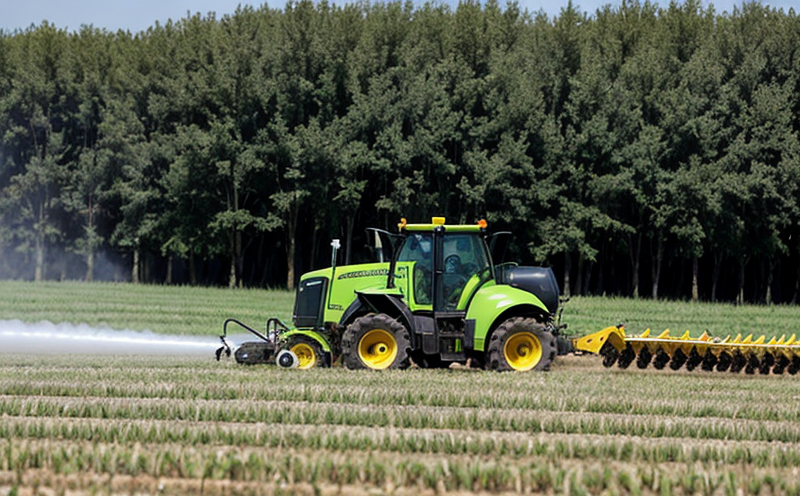Glyphosate Residue Testing in Crops Validation Method Development Test
The demand for accurate and reliable glyphosate residue testing is paramount in agriculture and forestry, particularly as regulatory pressures increase. Glyphosate is one of the most widely used herbicides globally, and its presence can significantly impact crop quality and marketability if not managed properly. Our comprehensive validation method development tests ensure compliance with international standards like ISO 17259-1 for quantitative analysis and ISO 6803:2009 for qualitative detection.
Our service includes a detailed validation process, which involves several critical steps:
- Method Validation: Establishing the method's accuracy, precision, linearity, and robustness.
- Sample Preparation: Ensuring that samples are prepared according to standardized protocols to avoid contamination or loss of analyte.
- Analytical Instrumentation: Utilizing state-of-the-art equipment such as High-Performance Liquid Chromatography (HPLC) and Mass Spectrometry (MS).
- Calibration and Quality Control: Implementing rigorous calibration procedures to ensure accurate measurements, along with the use of quality control samples at different levels.
- Data Analysis and Reporting: Providing detailed reports that include raw data, statistical analysis, and interpretation of results.
The testing process is critical for ensuring product safety, maintaining consumer trust, and adhering to regulatory requirements. Accurate residue testing helps farmers make informed decisions about the use of glyphosate, thereby minimizing risks associated with overuse or improper application.
| Method Validation Parameters | Description |
|---|---|
| Accuracy | The degree to which measurement results agree with the true value. |
| Precision | The degree of agreement between repeated measurements under identical conditions. |
| Linearity | The relationship between measured values and nominal concentrations. |
| R robustness | The ability to perform consistently across different environmental or operational conditions. |
In addition, our team of experts can assist in the development of bespoke testing protocols tailored to specific crop types and agricultural practices. This ensures that clients receive a service that is not only compliant but also optimized for their unique requirements.
Why It Matters
Glyphosate residue testing plays an essential role in ensuring food safety, environmental sustainability, and regulatory compliance. With increasing scrutiny from consumers and regulators alike, the need for accurate and reliable tests is more critical than ever before. Our service goes beyond mere compliance; it provides actionable insights that can help stakeholders make informed decisions about their agricultural practices.
- Consumer Confidence: Ensures that products meet or exceed safety standards, thus building trust with consumers.
- Regulatory Compliance: Helps businesses avoid fines and penalties by ensuring adherence to strict regulatory requirements.
- Sustainable Agriculture: Provides data to optimize the use of pesticides, reducing environmental impact while maintaining productivity.
- Better Decision Making: Offers detailed insights that can guide improvements in agricultural practices and product development.
By partnering with us for glyphosate residue testing, stakeholders benefit from a comprehensive service that supports both short-term compliance needs and long-term sustainability goals. This commitment to excellence ensures that every client receives the highest quality of results, thereby enhancing their reputation and market position.
Scope and Methodology
The scope of our glyphosate residue testing includes a detailed validation process designed to meet international standards such as ISO 17259-1 for quantitative analysis and ISO 6803:2009 for qualitative detection. Our methodology ensures that tests are conducted under controlled conditions, using calibrated instruments to achieve precise and reliable results.
| Key Methodology Components | Description |
|---|---|
| Sample Collection | Sampling is done according to predefined protocols to ensure representativeness and avoid contamination. |
| Extraction | An extraction process that removes glyphosate from the sample, ensuring it can be accurately measured in subsequent steps. |
| Cleanup | A cleanup step to remove interfering compounds, improving the sensitivity and accuracy of the test. |
| Instrumentation | Use of HPLC-MS/MS for precise quantification of glyphosate residues in crops. |
| Data Analysis | Statistical analysis to interpret results, ensuring that they are both accurate and meaningful. |
The methodology is designed not only to meet regulatory requirements but also to provide insights into the effectiveness of current agricultural practices. This holistic approach ensures that clients receive a comprehensive service that supports their broader goals in agriculture and forestry.
Industry Applications
- Farmers: To ensure proper application rates, avoid overuse, and maintain crop quality.
- Agricultural Companies: For compliance with international standards and to enhance product safety.
- R&D Engineers: To develop new formulations that are both effective and safe for use.
- Procurement Teams: To verify the integrity of imported products, ensuring they meet quality and safety standards.
- Government Agencies: For regulatory oversight and enforcement.
The ability to accurately measure glyphosate residues is crucial across various sectors. Our service ensures that stakeholders can make informed decisions based on reliable data, supporting their efforts in maintaining high-quality products while adhering to stringent regulations.





